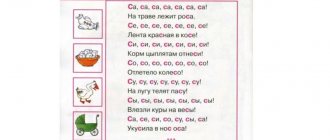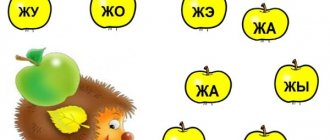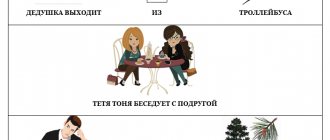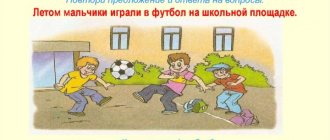Maze games are educational pictures depicting intricate paths or lines, to complete which you need to find the correct route from entrance to exit, trying not to get into dead ends.
Such tasks encourage children to sort through possible options, teach them to perceive the whole picture, analyze information and find the right solutions. Exercises with labyrinths:
- develop imagination, logical thinking, attention and perseverance;
- train short-term and long-term memory;
- stimulate mental development;
- improve hand and finger coordination.
Below you will find many free mazes of different difficulty levels. You can complete them either on a computer or tablet screen, or in paper form. To do this, first download and print the pictures you like.
Simple mazes for children 3-4 years old
Children at this age are open to everything new, approach learning with enthusiasm, perceiving it as nothing more than just another game. Therefore, it is important for every parent not to eradicate this zeal with developmental activities and exercises, but to develop and increase it.
Remember a few unspoken rules that should guide you during your studies:
- You cannot replace the time allocated for your child to watch his favorite cartoon with maze games.
- Sit down to study when your baby is in a good mood.
- For the first time, you should not give complex tasks; choose the simplest and easiest options, with one path and a minimum number of dead ends.
- You don't have to start playing right away. Talk to your child, find out what he sees in the picture, whether he likes it or not, etc. If you notice that for some reason the picture itself is not attractive to the baby, replace it with another one.
- In a situation where the simplest option was initially chosen and the child could not cope with it, during the next attempts offer another picture that the child has not yet seen.
- If the child loses interest after the first attempt without even going through one picture, put it aside for 5-7 days, and then try again.
- Observe how the child approaches the search for a way out: he does it at random or sees the whole picture and, analyzing it, builds a path. If you notice that your child does not navigate the drawn labyrinth and constantly ends up in dead ends, perhaps you should immediately practice on three-dimensional types, and then return to flat paper versions.
- When faced with a complete refusal to go through mazes, try to find pictures with your favorite cartoon characters, animals, cars, etc. Give preference to maze games made on the principle of coloring. Having seen the painted idols, the baby will definitely show interest in coloring them, and then, perhaps, he will want to complete the task itself.
Where to begin?
1. At the first stage, you need to see how confidently the child holds a pencil in his hand. If he manages to draw a line, albeit a curve, or paint over the path of the labyrinth, proceed to step 2.
If it doesn’t work out, but you notice an emerging interest in a new game, practice drawing lines on a regular sheet of paper or painting individual small areas:
Draw an impromptu smooth path, and let the child independently draw a line-path along it. If it works, make the task more difficult for him and draw a curved path. This way, you will train his hand and after 1-3 lessons you will be able to start going through picture labyrinths.
Same with painting. Draw a small path on a landscape sheet and ask them to color it. It's okay if the child does it a little carelessly, going beyond the boundaries. With constant practice he will learn to paint accurately;
There is another way when the child points the way with his finger, and you sketch the route behind him. This approach is considered more difficult for a child because it triggers more thought processes, but, as practice shows, for some children it is more acceptable if they lack the skills to coordinate hand movements for drawing lines or painting.
2. Take a picture your little one likes and talk to him about:
- what exactly is shown in the picture;
- what situation did the heroes of the labyrinth find themselves in;
- how you can help them;
Find out if the baby understands where the entrance and exit are. If the child can’t figure it out on his own, it’s okay, just show them to him and explain why they are located here. Please note that in almost all simple pictures, “entry” and “exit” are marked with arrows.
Ask them to use their eyes or fingers to look for the right path. When the baby says that he found it, let him draw a line with a pencil from the entrance to the exit. If you notice that the baby is confused, help him through the passage by asking leading questions or giving hints.
Be sure to praise your child and support him. You can come up with your own motivational rewards, for example, in the form of stickers in the “Success Diary”. But in this case, do not buy sets that carry a negative image. Choose positive, cheerful characters and after each passage or attempt, stick 1 piece on the diary page. For example, if it passed - the sun, if it didn’t pass, but tried - a flower. This approach can be used in other educational games.
Take your child through these maze games with funny animals.
Labyrinth No. 1
The baby rhino gets lost and doesn't know how to get to the palm tree with delicious coconuts. There is only one correct way to get there. Guide the rhino along the shortest route.
Labyrinth No. 2
The little koala is tired and wants to rest in the shade of two tall palm trees. Find the shortest path to the trees.
Labyrinth No. 3
The baby elephant is tired of the unbearable heat of Africa and is very thirsty, but does not know how to quickly get to the river. Show him the shortest path to water.
Using elements of the “Fairy Tale Mazes Game” technology in the work of a speech therapist
Using elements of the “Fairy Tale Mazes Game” technology in the work of a speech therapist
Master Class
Equipment: screen, projector, felt-tip pens or markers, Games by V.V. Voskobovich: “Labyrinth of letters”, “Objective world around us”, “Reader on balls”, “Literacy cord: Apple tree, Snowman, Chamomile”, “Unusual animal” ", "Literary Circus".
Progress of the event: Participants sit at tables in front of the screen. An accompanying presentation is projected onto the screen.
— I would like to start my master class with a quote from Alexander Svechnikov’s play “Journey into History”:
King Prometheus asked Euclid: “Isn’t there a shorter and less tedious path to knowledge?” To which the scientist replied: “There is NO royal road to knowledge.”
At the present stage of development of education, the problem of increasing the number of children with special needs has become acute. Accordingly, the problem of preventing and overcoming school maladaptation in this category of children manifests itself in low academic performance and difficulties in relationships with others. Meanwhile, socio-economic transformations in society dictate the need to form a creatively active personality with the ability to effectively and creatively solve life’s problems.
The development of children's speech is largely determined by the awareness of the need to use language. In play, as the leading activity of preschool children, the most favorable prerequisites are created for the formation of various mental properties and personality traits. In this regard, in domestic psychology and pedagogy, great importance is attached to the implementation of the developmental nature of the game when teaching children. (L.S. Vygotsky, D.B. Elkonin)
The speech therapy literature notes the specificity of play activities in children with SLI; scientific and methodological aspects of the use of games as a correctional tool have been developed (V.I. Seliverstov, T.B. Filicheva). Developmental education promotes accelerated maturation of the brain and improvement of its functions.
The use of educational games in the correctional pedagogical process makes it possible to reconstruct educational activities: move from the usual activities with children to play activities organized by adults or independently, removes excessive didacticity of teaching, allows solving problems of a motivational nature, and contributes to the implementation of high-quality individualization of children's education.
Among the variety of educational games familiar to us from pedagogical didactics, a very special, creative and kind Technology for the intensive development of intellectual abilities in children “Fairytale labyrinths games” has appeared. V.V. Voskobovich.
Medium difficulty labyrinths for children 5–6 years old
For children 5-6 years old, choose pictures of medium complexity in which:
- the path has many twisting intersecting paths;
- the number of dead ends has been increased compared to the previous difficulty level;
- there is no entry arrow, since the child must choose which path to take to get to the given goal.
After your child completes 5-10 labyrinths of medium difficulty, invite him to try to complete the task without the help of a pencil. To avoid confusion at first, you can use your finger or pointer.
At the next stage of complicating the tasks, you need to train to look for the way to the exit only with your eyes, and after finding it, show the right path to an adult. Such exercises will prepare the child to navigate complex labyrinths.
Labyrinth No. 1
The mother hen can't find the third chick to hatch. Help her quickly get to the baby in the shell along the shortest path and gather her babies together.
Labyrinth No. 2
While the mother dragon was hunting, the baby hatched from the egg. Show her the shortest path to the baby dragon, leading her past dead ends.
Labyrinth No. 3
The bear wants to eat the honey, but the bees carefully guard it. Help him choose the right path to quickly get to the treasured treat and avoid getting caught by bees along the way.
Speech therapy game "Walker" methodological development on speech therapy on the topic
Description:
These are innovative speech therapy labyrinths/walkers*. The innovation of these author's speech therapy labyrinths/walkers lies in the fact that any speech material can be selected for any playing field. And this is achieved using a laminator and textile tape (Velcro).
So, the innovativeness of speech therapy labyrinths lies in the possibility of selecting original speech material:
- completely excluding the use of sounds in words that the child pronounces incorrectly, which corresponds to the basic principle of the formation of correct pronunciation (Fig. 1 - automation [k]; the sound composition of words excludes the use of sounds of late ontogenesis: [w], [zh], [l] ,[R]).
- meets the laws of sound automation: going through speech therapy labyrinths, the sounds can be automated in isolation, then gradually, sequentially introduced into syllables (direct, reverse, with a consonant cluster), words (at the beginning, middle, end), sentences, tongue twisters and quatrains. (Fig. 2 - automation [w] at the beginning of a word), Fig. 3 - automation [p] in the middle of a word; Fig. 4 - automation [s] at the end of a word).
In order to make the process of automating corrected sounds truly exciting and effective, so that the child does not get bored with repeatedly repeating the same speech material (and when automating the sounds of early ontogenesis, it is very difficult to select speech material that corresponds to the basic principle of forming correct pronunciation), it is possible to use different speech therapy playing fields. The kid will not care that he repeats the same words, since in one case, by naming the proposed pictures, he helps the artist name all the pictures that he drew, and in the other, he helps the frog Kwa-Kwa pass through the swamp (Fig. 5, Fig. 6).
The format of the playing fields can be different - depending on the goals and objectives of your lesson. If you are automating the sound at the beginning (middle, end) of a word, you can take A4 format, but if you are working on differentiating sounds, for example [P] and [L], you will need a field in A3, A3*2, A3*3 format since it can accommodate a larger number pictures (Fig. 7, Fig. 8).
If the player lands on a cell with the “lips” icon, then he must recite a simple saying or rhyme; if with the “?” icon, then he must come up with a word for a given sound, but if with the “123” / “5” icon, then he must count. For a well-told proverb, rhyme, counting rhyme, or correctly coined word, the player receives the right to move one cell forward (Fig. 6).
*Walker (Fig. 9) - the child “walks” through the pictures with his index and middle fingers, stepping on the pictures. The exercise also develops coordination of finger movements.
Objectives of the manual (underlined):
Here's another secret of these labyrinths/walkers: they are not just innovative, but also universal. By playing these labyrinths, you can not only automate the corrected sounds (Fig. 10), but also using the same playing fields: differentiate sounds (Fig. 11), teach (study) letters (Fig. 12), perform articulatory gymnastics ( Fig. 13), work on the lexical structure of speech (vocabulary work) (Fig. 14, Fig. 15), carry out corrective work to overcome violations of the syllabic structure of words (Fig. 16).
Make tasks for your child even more exciting and emotionally charged; aimed at developing the child’s personal characteristics, the ability to overcome uncertainty, and his experience of free will, you can use the following technique - “Choice situation”. In other words, we create the necessary conditions for the formation of his active self by organizing the opportunity for him to choose pictures himself and create a labyrinth (Fig. 17). Of course, the speech therapist himself must choose pictures in accordance with the goals and objectives of the exercise in advance
Child category and age:
And also the versatility of these speech therapy labyrinths/walkers lies in the fact that there is no strict age limit. Can be used from 2.5 (more to play walking games than the maze itself) years to 9 years. You can play using this game guide with almost all categories of children with disabilities: children with general speech underdevelopment, severe speech disorders, mental retardation, speech delay, children with Down syndrome, cerebral palsy, and so on. the same with children who develop without special needs, but have disturbances in sound pronunciation.
Contents of the manual:
Option I. Sound automation.
Goal: to consolidate the correct pronunciation of sounds, to develop intelligence, attention, memory, and the ability to follow the rules.
Number of players: from 1 to 4 people.
Materials: playing field, automated sound cards (which do not contain words that the child pronounces incorrectly), cube, chips (you can use small voluminous toys, for example, from Kinder surprises)
Game progress: each player receives one chip and places it on the “Start” cell. Using a counter, the order of moves is determined. Players take turns tossing the dice and moving forward as many squares as the number rolled on the dice, naming the pictures along the way. If a player lands on a cell with an icon depicting lips, then he must recite a tongue twister or rhyme with an automated sound, if with an icon depicting a question mark, then he must come up with a word with an automated sound. For a well-told proverb, rhyme, or correctly named word, the player receives the right to move one cell forward. The winner is the one who reaches the “Finish” first and with the most cards. At the end, you can repeat who has which card.
Option II. Learning letters
Goal: to consolidate the representation of graphic images of letters, to develop intelligence, attention, memory, and the ability to follow the rules.
Number of players: from 1 to 4 people.
Material: playing field, graphic images of letters (which the child already knows), cube, chips (you can use small voluminous toys, for example, from Kinder surprises)
Game progress: each player receives one chip and places it on the “Start” cell. Using a counter, the order of moves is determined. Players take turns tossing the dice and moving forward as many squares as the number rolled on the dice, calling out the letters along the way. If a player lands on a square with an icon depicting a palm, then he must guess what letter the presenter (speech therapist) drew on his palm, if with an icon depicting a question mark, then he must think of a letter and depict it with his hands/body. For a guessed letter or correctly depicted letter, the player gets the right to move one cell forward. The winner is the one who reaches the “Finish” first and with the most cards. At the end, you can repeat who has which card.
Option III. Learning new words (vocabulary work)
Goal: clarify, expand and activate the vocabulary on the topic, develop intelligence, attention, memory, and the ability to follow the rules.
Number of players: from 1 to 4 people.
Materials: playing field, cards on a specific topic, cube, chips (you can use small voluminous toys, for example, from Kinder surprises)
Game progress: each player receives one chip and places it on the “Start” cell. Using a counter, the order of moves is determined. Players take turns tossing the dice and moving forward as many squares as the number rolled on the dice, naming the pictures along the way. If a player lands on a cell with an icon depicting lips, then he must come up with a word on a given topic, if with an icon depicting a question mark, then he must solve the riddle. For correctly coining a word or solving a riddle, the player receives the right to move one cell forward. The winner is the one who reaches the “Finish” first and with the most cards. At the end, you can repeat who has which card and clarify how it all can be called in one word.
Option IV. We are working on the syllabic structure of the word.
Goal: to overcome violations of the syllabic structure of words, to develop intelligence, attention, memory, and the ability to follow the rules.
Number of players: from 1 to 4 people.
Materials: playing field, cube, chips (you can use small voluminous toys, for example, from Kinder surprises), word cards according to the classification of A.K. Markova, which distinguishes 14 types of syllable structure of a word in increasing degrees of complexity:
1. Two-syllable words made from open syllables (willow, children). 2. Three-syllable words made from open syllables (hunting, raspberries). 3. Monosyllabic words (house, juice). 4. Two-syllable words with a closed syllable (sofa, furniture). 5. Two-syllable words with a cluster of consonants in the middle of the word (bank, branch). 6. Two-syllable words made from closed syllables (tulip, compote). 7. Three-syllable words with a closed syllable (hippopotamus, telephone). 8. Three-syllable words with a combination of consonants (room, shoes). 9. Three-syllable words with a consonant cluster and a closed syllable (lamb, ladle). 10. Three-syllable words with two clusters of consonants (tablet, matryoshka). 11. Monosyllabic words with a combination of consonants at the beginning of the word (table, closet). 12. Monosyllabic words with a consonant cluster at the end of the word (elevator, umbrella). 13. Two-syllable words with two consonant clusters (lash, button). 14. Four-syllable words made from open syllables (turtle, piano).
Game progress: each player receives one chip and places it on the “Start” cell. Using a counter, the order of moves is determined. Players take turns tossing the dice and moving forward as many squares as the number rolled on the dice, naming the pictures along the way. The winner is the one who reaches the “Finish” first and with the most cards. At the end, you can repeat who has which card.
Option V. Differentiation of sounds
Goal: to learn to distinguish mixed sounds (based on motor characteristics) and to use them correctly in one’s own speech, to develop intelligence, attention, memory, and the ability to follow rules.
Number of players: from 1 to 4 people.
Materials: playing field, cards for differentiable sounds (not containing sounds in the word that the child pronounces incorrectly), cube, chips (you can use small voluminous toys, for example, from Kinder surprises)
Game progress: each player receives one chip and places it on the “Start” cell. Using a counter, the order of moves is determined. Players take turns tossing the dice and moving forward as many squares as the number rolled on the dice, naming the pictures along the way. If a player lands on a cell with an icon depicting lips, then he must recite a tongue twister or rhyme with an automated sound, if with an icon depicting a question mark, then he must come up with a word with an automated sound. For a well-told proverb, rhyme, or correctly named word, the player receives the right to move one cell forward. The winner is the one who reaches the “Finish” first and with the most cards. At the end, you can repeat who has which card.
Complex mazes for schoolchildren aged 7–8 years
Challenging maze games help develop persistence and patience. Observe your child’s behavior: does he start to get nervous when things don’t work out, and how quickly he gives up.
If you notice that your child is acting impatient, try to involve him in such activities more often. This will allow him to develop calmness when difficult situations arise and patience to overcome them.
Complex labyrinths are characterized by the presence of:
- many loops;
- peculiar intersections in the form of passages superimposed on each other;
- tasks to find connections or “what goes with what.” For example, “who owns which car” or “where is whose dog.”
If your child cannot find the right path, tell him that he can immediately try to find his way from the end of the maze. And then go through it from the start.
In order for the child’s skills to develop, make each subsequent task a little more difficult than the previous one.
Labyrinth No. 1
Mommy dinosaur can't find her hatched baby, but the sun is already setting and night is coming soon. Help her find the shortest route, avoiding all the dead ends before it gets dark and she gets completely lost.
Labyrinth No. 2
The mouse really wants to eat and has already prepared a knife and fork, but does not know how to get to the cheese. There are three roads. Help me find the one that will lead to the treasured delicacy.
Labyrinth No. 3
The dog cannot find his way to his owner. There are three paths, two of which will lead to a dead end. Show him the correct route by pointing him in the right direction at intersections.










